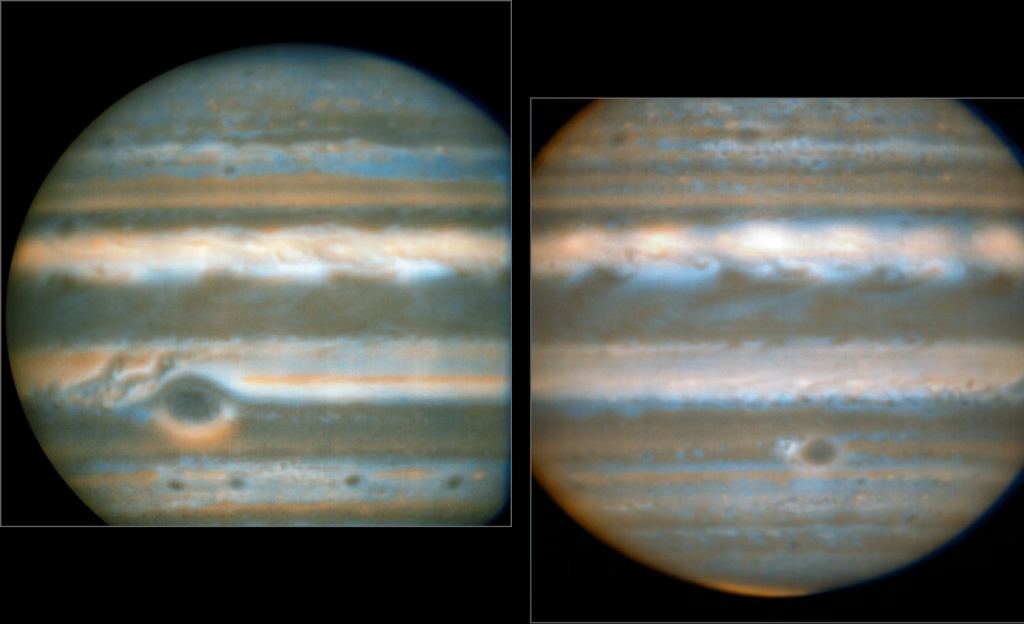Some of the most useful discoveries about distant objects take time to complete. For example, several generations of planetary scientists have been studying the clouds of Jupiter since the late 1970s. Their observations focused on the planet’s upper troposphere. The results show unexpected patterns in how the temperatures of Jupiter’s belts and zones change over time.
Those temperatures rise and fall in cycles not tied to the seasons. That’s unusual since scientists didn’t expect to find such regular variations. It could be due to Jupiter’s very slight tilt on its axis. The four decades of observations also found a connection between temperature shifts in regions several thousand kilometers apart. As temperatures rose at specific latitudes in parts of the Jovian northern hemisphere, they fell at the same latitudes in the southern hemisphere. Is there a connection?
“That was the most surprising of all,” said Glenn Orton, a senior research scientist at NASA’s Jet Propulsion Laboratory and lead author of a study based on the observations. “We found a connection between how the temperatures varied at very distant latitudes. It’s similar to a phenomenon we see on Earth, where weather and climate patterns in one region can have a noticeable influence on weather elsewhere, with the patterns of variability seemingly ‘teleconnected’ across vast distances through the atmosphere.”
Observing Jupiter’s Clouds
Jupiter, as we all know, is covered with thick clouds. It has the largest and most complex planetary atmosphere in the solar system and is a natural laboratory where scientists can study interactions between the belts and zones, the creation and evolution of giant whirling windstorms, and other atmospheric activity. It’s also a natural laboratory for understanding the atmospheres of other giant planets. Surprisingly, its troposphere (the lowest region of the atmosphere, which sits atop the “surface” of Jupiter’s liquid interior) is pretty similar to Earth’s. That’s because the troposphere on both planets is where clouds form and where storms whirl.

Credit: ESO / L.N. Fletcher
To understand the tropospheric weather, scientists needed more data about the winds, atmospheric pressure, humidity, and temperatures. They have known since the Pioneer missions that Jupiter’s lighter and whiter bands (known as zones) are generally colder. The darker brown-red bands (known as belts) are where temperatures are warmer. But, planetary scientists needed long-term measurements to understand how the weather changes over time.
So, Orton’s team used observatories in Chile and Hawai’i to take the temperatures of cloud zones and bands of Jupiter. Starting in 1978, they studied the bright infrared glow that rises from warmer regions on Jupiter. That allowed them to directly measure the temperature of the troposphere. They collected their data during three of Jupiter’s 12-year orbits around the Sun. After several decades, they began to combine the data from the observations into a coherent “picture” of Jupiter’s tropospheric weather.
An Atmospheric Scientist’s Work is Never Done
This time-domain study of Jupiter’s lower atmosphere is a good start on understanding what causes the cyclical and apparently synchronized changes it undergoes. But, of course, more work needs to be done. “We’ve solved one part of the puzzle now, which is that the atmosphere shows these natural cycles,” said study co-author Leigh Fletcher of the University of Leicester in England. “To understand what’s driving these patterns and why they occur on these particular timescales, we need to explore both above and below the cloudy layers.”
Perhaps changes in the stratosphere influence changes in the troposphere and vice versa. But, what mechanism explains the linkage between temperature changes across wide areas of the planet? Further observations should help find a link if there is one. In the meantime, scientists think that the results of this 40-year study could help them predict Jupiter’s weather even as they seek to understand the observed changes.
The next step will be to create improved climate models for the giant planet. The data will feed computer simulations of the temperature cycles Orton and the team have measured. Then, they could use that information to predict how the variations affect weather. The information could help with similar predictions at Saturn, Uranus, and Neptune.
For More Information
40-Year Study Finds Mysterious Patterns in Temperatures at Jupiter
Unexpected long-term variability in Jupiter’s tropospheric temperatures
The post An Ongoing Study of Jupiter’s Cloudtops Has Been Going on for 40 Years appeared first on Universe Today.
No comments:
Post a Comment